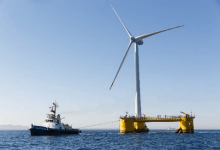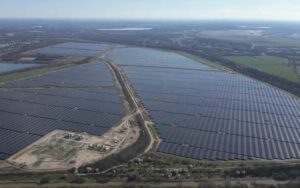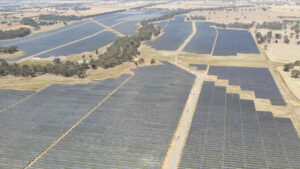The UK government has awarded seabed rights to developers of Blue Gem Wind, a 96MW floating wind demonstration project that will be Wales’ first-ever floating wind farm.
Blue Gem Wind, a joint venture between French oil and gas supermajor Total and British renewables developer Simply Blue Energy, was cleared for development around 44km off the coast of Wales in the Celtic Sea.
Currently, Blue Gem Wind is hailing its planned 96MW ‘Erebus’ floating offshore wind demonstration project as “the largest floating offshore wind project in the world,” with construction due to be is completed in 2027.
Judging by the development of floating offshore wind technology and a marked increase in interest for the technology, it is unlikely Erebus will
hold onto this particular catchcry for long.
Floating wind’s promise lies in the fact that 80% of the world’s wind resources are in water deeper than 60 metres – thus making them unreachable and cost-ineffective for the majority of traditional wind turbine designs.
With studies suggesting that there could be as much as 50GW of electricity capacity available in the Celtic Sea, Blue Gem Wind is hoping to capitalise on the benefits of floating wind as a key tool in helping to meet the UK’s goal of net-zero emissions by 2050.
“We are incredibly pleased to sign the Agreement for Lease for Erebus,” said Hugh Kelly, Blue Gem Wind’s project managing director.
“This first project in Wales will begin to unlock the significant potential of floating wind in the Celtic Sea. It is the first of the stepping-stone projects required to launch a new chapter in the development of offshore energy in the South West; a new industry that can deliver significant benefits for the local supply chain and the coastal communities of Wales and the wider UK.”
The award of seabed rights to Blue Gem Wind is part of The Crown Estate’s larger and ongoing Offshore Wind Test and Demonstration opportunity, which is designed to facilitate pre-commercial innovation through the trial of new and emerging technologies in live conditions.
The Crown Estate, the government body responsible for managing the seabed around Wales, England, and Northern Island, believes that floating technologies are better suited to deeper waters and are set to play a significant role in the future of UK offshore wind development.
“Welsh waters are home to a thriving offshore wind industry and as this continues to evolve and mature, innovation will be vital to unlocking a sustainable pipeline of new capacity over the longer term,” said Will Apps, head of energy development at The Crown Estate.
“With an increasingly busy marine environment, we need to explore new technologies in more diverse and technically challenging areas which is why we are delighted to see the Erebus Project take this important step.”
The announcement was made alongside two further offshore wind developments for Wales, as The Crown Estate also awarded seabed rights for the proposed extension of the 576MW Gwynt y Môr offshore wind farm, located 13km off the coast of North Wales.
The Awel y Môr extension project could deliver up to 576MW of additional capacity to the offshore wind farm and dramatically boost Wales’ own net-zero ambitions.
The second announcement made, but already confirmed in 2019, is the inclusion of areas of Wales’ seabed in The Crown Estate’s Offshore Wind Leasing Round 4, the first major UK leasing round in a decade, which is set to identify projects later this year as part of a competitive tender process, which could award rights in 2021 for operation by 2030.
“The climate emergency means we will need much more renewable energy to meet our needs, and Welsh Government has supported the development of marine energy for many years,” said minister for environment, energy and rural affairs, Lesley Griffiths.
“I am pleased to welcome this next step in harnessing the potential for energy identified in the recently published Wales National Marine Plan. We will continue to ensure projects bring sustainable jobs and investment to Wales whilst delivering on our legally binding climate commitments.”










